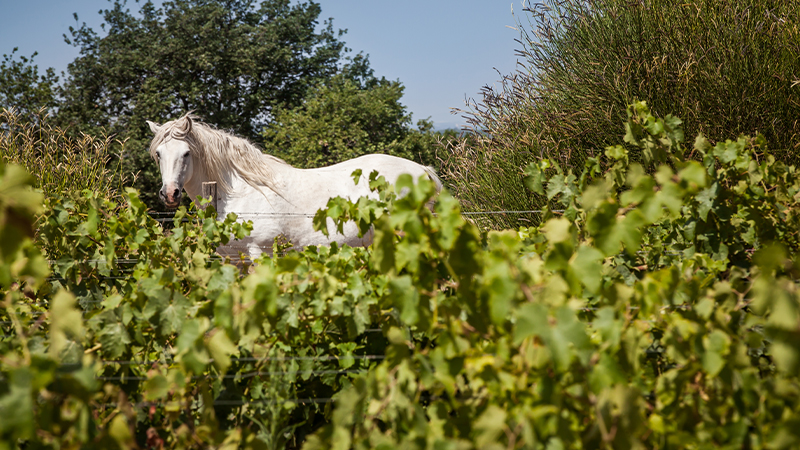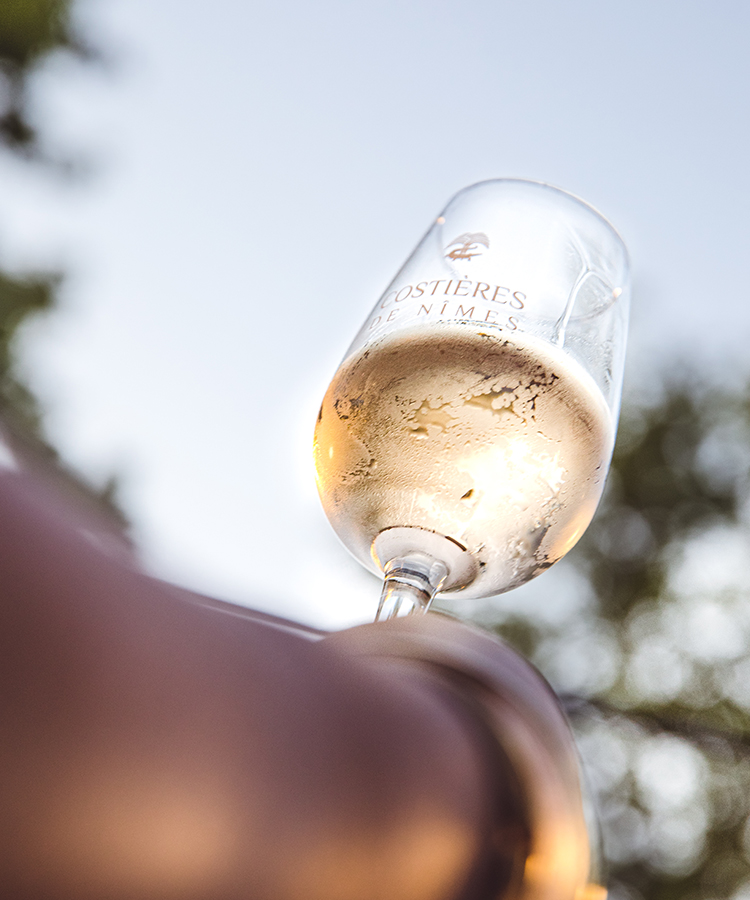If you are in the market to try new wines this summer, stock up on bottles from Costières de Nîmes. “Costi de what?” you may say, but don’t worry. We are going to tell you all about this wine-centric place at the southernmost edge of the Rhône Valley. It remains little known to American wine drinkers. In fact, it is considered one of the Rhône Valley’s best kept wine secrets, but make no mistake –– these lively wines will not fly under the radar for much longer.
What do the wines from the region taste like? Imagine if someone were able to bottle the sea breeze blowing through the cobblestoned streets of a French Mediterranean town. Basically, they taste like that.
A Little History
Winemakers have been making wine in the area since before France existed. Think all the way back to before the Romans made everything their empire, and all the way back to ancient Greece.
The Rhône Valley is named after the wanderlusting, wine-loving Greeks who brought vines with them when they settled southern France in the 4th century B.C. These early settlers, who hailed from the Greek Island of Rhodes, named the river and the valley Rodanos, which eventually morphed into, you guessed it, the Rhône Valley. The ancient Greeks are thought to have started planting grapevines in 600 B.C. making Costières de Nîmes one of the oldest wine regions in the world.
Veterans of Octavius’s famous Actium battle settled the area next. The Romans perfected what the Greeks started by increasing plantings, refining wine production, and building wineries. They also improved the processes for storing wine by using earthenware vessels. These vessels left historians a roadmap of ancient wine-producing techniques as well as proof that the Rhône Valley vineyards are some of the oldest on Earth.
Fast forward to modern times. The appellation Costières de Nîmes was created in 1989 and became the southernmost AOC of the Rhône Valley.
A Terroir of Sea Breezes
Costières de Nîmes sits on the western part of the Rhône Delta where the Rhône, Gardon, and Durance rivers become one before flowing out to the Mediterranean Sea. The landscape between Nîmes and the Mediterranean Sea is relatively flat and low-lying. The soil, formed by prehistoric rivers, is made up of red, sandy clays with an interspersing of large rocks and pebbles.
The climate is Mediterranean, similar to that of the Rhône Valley. There, the air is dry and sunny, especially in the summer when drought conditions are common. Its one main characteristic, however, is its proximity to the coast as the sea breezes give the wine impeccable freshness. Moreover, while the area is largely arid, a sea wind blows through every afternoon to cool off the vines. The famous, cool, northern “Mistral” wind from the upper Rhône Valley blows in to temper the summer temperatures. The area has a sizable difference between day and nighttime temperatures. This swing in temperatures produces grapes with firm acidity, and translates into bottles of crisp, fresh, lively wines.
The Wines
Costières de Nîmes is a red wine and rosé region, with red comprising roughly 50 percent and rosé 40 percent of the region’s wine respectively. White wine makes up a paltry 10 percent of area production, but what it lacks in quantity, it makes up for in quality. Grenache Blanc, Marsanne, and Roussanne are the area’s trifecta of white grapes and must form at least half of any white blend.
Grenache Blanc with its green plum, citrus zest, and pear flavors; Marsanne with its deep color and notes of roasted nuts, white peaches, and flowers; and, of course, Roussanne, with its bright floral aromas and flavors of stone fruit, nuts, and baked bread all blend together for some of the most refreshing white wines on the planet.

While these wines tend to lean toward citrus and white flowers, the rosés slope toward vivacious red fruit.
Costières de Nîmes requires that Grenache, Syrah, and Mourvèdre make up at least 60 percent of the finished rosé wines. Grenache produces fruity wines that stop just short of sweetness while Mourvèdre produces bold, vibrant wines with high alcohol. Syrah is a full-bodied, dry wine with firm tannins and brisk acidity.
The results are relatively pale soft, crisp wines with notes of strawberry, raspberry, and cherries. Costières de Nîmes rosés have been described as being “as refreshing as a Mediterranean beach in summer” and having “a mineral-y finish that is clean and crisp to keep you sippin’ all afternoon long.”
Whether you are drinking a glass of white wine on a summer evening or rosé all day, freshness is the key characteristic that ties all Costières de Nîmes wines together. So the next Sunday you find yourself craving a crisp wine with bright acidity –– or a rosé as fruit-driven as the blooms around you –– look to one of these wines, and prepare for an afternoon of easy drinking.
Of course, if you prefer a glass of ripe red wine, Costières de Nîmes remains yours for the picking. Most reds arriving from the appellation will spring with just as much fresh fruit as the whites and rosés, and are made with the Rhône Valley’s preferred blends of Grenache, Syrah and Mourvèdre. Other grapes like Carignan and Cinsault lend fruit and body when needed, but no matter the wine, you can count on the juice to remain smooth and aromatic.
Look for notes of bright red fruit, blackberries, and dark black cherries in these elegant red wines, which may become a must come dinner time. For those looking to pair the red wines with food, simply look to common barbecue or delicious grilled tuna to seal the deal. Otherwise, if you’re just trying to assemble a light, bright lunch menu with your favorite Costières de Nîmes white wine, try chopping a honey-braised ham or shrimp over your favorite spring mix. A warm plate of calamari will also do the trick, and ensure even the hungriest oenophiles leave happy.
More than anything, Costières de Nîmes wines are simply made to be enjoyed. With so many beautiful bottles offering zippy fruit and aromatics, the appellation offers any eager wine lover plenty of careful research –– and discovery –– to be gained. So experiment with the different styles and pick your favorites for yourself, because only you can decide what wine will keep you going back.
Check out the video below to learn more!
This article is sponsored by Costières de Nîmes. Photo Credit: Charlène Pélut
